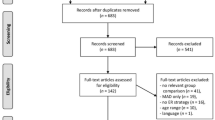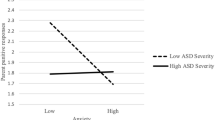Abstract
Deficits in emotion regulation (ER) are an important factor in maintaining social anxiety disorder (SAD) in adults. As SAD and ER problems typically develop during childhood and adolescence, and are maintained dynamically within the parent–child dyad, research on families can help to reveal the role ER plays in the early development of SAD. The current study assessed self-reported habitual ER in dyads of children with SAD (n = 31), children with mixed anxiety disorders (MAD; n = 41) and healthy control children (HC; n = 36), and their parents. Results indicate a transdiagnostic quality of ER in that, children with SAD and children with MAD similarly reported less adaptive and more maladaptive ER strategies than HC children, whereas no group differences in parental ER strategies emerged. Furthermore, children’s ER strategies aggressive action, withdrawal and self-devaluation and the parental ER strategy reappraisal were associated with social anxiety symptoms. These results suggest that there may be deficits in ER which generalize across childhood anxiety disorders. Our results are discussed in relation to current theories and their implications for treatment of childhood SAD.
Similar content being viewed by others
References
Achenbach TM (1991) Manual for the Child Behavior Checklist/4-18 and 1991 Profile. University of Vermont Department of Psychiatry, Burlington, VT
Aldao A (2013) The future of emotion regulation research: capturing context. Perspect Psychol Sci 8(2):155–172. doi:10.1177/1745691612459518
Aldao A, Nolen-Hoeksema S, Schweizer S (2010) Emotion-regulation strategies across psychopathology: a meta-analytic review. Clin Psychol Rev 30(2):217–237. http://www.redi-bw.de/db/ebsco.php/search.ebscohost.com/login.aspx%3fdirect%3dtrue%26db%3dpsyh%26AN%3d2010-01495-006%26site%3dehost-live
Asbrand J, Svaldi J, Krämer M, Breuninger C, Tuschen-Caffier B (2016) Familial accumulation of social anxiety symptoms and maladaptive emotion regulation. PLoS One 11(4):e0153153. doi:10.1371/journal.pone.0153153
Bariola E, Gullone E, Hughes EK (2011) Child and adolescent emotion regulation: the role of parental emotion regulation and expression. Clin Child Fam Psychol Rev 14(2):198–212. doi:10.1007/s10567-011-0092-5
Barrett P, Turner C, Lowry-Webster H (2000) Friends for children group leader’s manual. Australian Academic Press
Beesdo K, Knappe S, Pine DS (2009) Anxiety and anxiety disorders in children and adolescents: developmental issues and implications for DSM-V. Psychiatr Clin N Am 32(3):483–524. doi:10.1016/j.psc.2009.06.002
Beidel DC, Turner SM, Morris TL (1999) Psychopathology of childhood social phobia. J Am Acad Child Adolesc Psychiatry 38(6):643–650
Bonanno GA, Burton CL (2013) Regulatory flexibility: an individual differences perspective on coping and emotion regulation. Perspect Psychol Sci 8(6):591–612. doi:10.1177/1745691613504116
Buckholdt KE, Parra GR, Jobe-Shields L (2014) Intergenerational transmission of emotion dysregulation through parental invalidation of emotions: implications for adolescent internalizing and externalizing behaviors. J Child Fam Stud 23(2):324–332. doi:10.1007/s10826-013-9768-4
Carthy T, Horesh N, Apter A, Gross JJ (2010) Patterns of emotional reactivity and regulation in children with anxiety disorders. J Psychopathol Behav Assess 32(1):23–36. doi:10.1007/s10862-009-9167-8
Cisler JM, Olatunji BO, Feldner MT, Forsyth JP (2010) Emotion regulation and the anxiety disorders: an integrative review. J Psychopathol Behav Assess 32(1):68–82. doi:10.1007/s10862-009-9161-1
Cohen J (1988) Statistical power analysis for the behavioral sciences, 2nd edn. Lawrence Erlbaum Associates, Hillsdale
Cohen J (1992) A power primer. Psychol Bull 112(1):155
Cole PM, Michel MK, Teti LO (1994) The development of emotion regulation and dysregulation: a clinical perspective. Monogr Soc Res Child Dev 59(2–3):73–102
Cole PM, Martin SE, Dennis TA (2004) Emotion regulation as a scientific construct: methodological challenges and directions for child development research. Child Dev 75(2):317–333. doi:10.1111/j.1467-8624.2004.00673.x
Döpfner M, Schnabel M, Goletz H, Ollendick TH (2006) PHOKI: Phobiefragebogen für Kinder und Jugendliche. Hogrefe, Göttingen
Döpfner M, Berner W, Schmeck K (2003) Elternfragebogen über das Verhalten von Kindern und Jugendlichen (CBCL/4-18). Arbeitsgruppe Kinder-, Jugend-und Familiendiagnostik
Fernandez KC, Jazaieri H, Gross JJ (2016) Emotion regulation: a transdiagnostic perspective on a new RDoC domain. Cognit Therapy Res. doi:10.1007/s10608-016-9772-2
Franke GH, Derogatis LR (2000) BSI: brief symptom inventory von LR Derogatis: (Kurzform der SCL-90-R): deutsche version: Testmappe: Beltz test
Gilbert KE (2012) The neglected role of positive emotion in adolescent psychopathology. Clin Psychol Rev 32(6):467–481. doi:10.1016/j.cpr.2012.05.005
Ginsburg GS, Siqueland L, Masia-Warner C, Hedtke K (2004) Anxiety disorders in children: family matters. Cognit Behav Pract 11:28–43
Grob A, Horowitz D (2014) Fragebogen zur Erhebung der Emotions regulation bei Erwachsenen (FEEL-E). Huber, Bern
Grob A, Smolenski C (2005) Fragebogen zur Erhebung der Emotions regulation bei Kindern und Jugendlichen: (FEEL-KJ). Verlag Hans Huber, Bern
Gross JJ (2015) Emotion regulation: current status and future prospects. Psychol Inq 26(1):1–26. doi:10.1080/1047840X.2014.940781
Han ZR, Shaffer A (2013) The relation of parental emotion dysregulation to children’s psychopathology symptoms: the moderating role of child emotion dysregulation. Child Psychiatry Hum Dev 44(5):591–601. doi:10.1007/s10578-012-0353-7
Hodson KJ, McManus FV, Clark DM, Doll H (2008) Can Clark and Wells’ (1995) cognitive model of social phobia be applied to young people? Behav Cognit Psychother. doi:10.1017/S1352465808004487
Insel T, Cuthbert B, Garvey M, Heinssen R, Pine DS, Quinn K, Wang P (2010) Research domain criteria (RDoC): toward a new classification framework for research on mental disorders. Am J Psychiatry 167(7):748–751
Jazaieri H, Morrison AS, Goldin PR, Gross JJ (2015) The role of emotion and emotion regulation in social anxiety disorder. Curr Psychiatry Rep. doi:10.1007/s11920-014-0531-3
Lange S, Tröster H (2014) Strategien der Emotions regulation bei sozial ängstlichen Kindern und Jugendlichen. Z Klin Psychol Psychother 43(1):35–42. doi:10.1026/1616-3443/a000246
Legerstee JS, Garnefski N, Jellesma FC, Verhulst FC, Utens EM (2010) Cognitive coping and childhood anxiety disorders. Eur Child Adolesc Psychiatry 19(2):143–150. doi:10.1007/s00787-009-0051-6
Legerstee JS, Garnefski N, Verhulst FC, Utens EM (2011) Cognitive coping in anxiety-disordered adolescents. J Adolesc 34(2):319–326. doi:10.1016/j.adolescence.2010.04.008
Lieb R, Wittchen H, Höfler M, Fuetsch M, Stein MB, Merikangas KR (2000) Parental psychopathology, parenting styles, and the risk of social phobia in offspring: a prospective-longitudinal community study. Arch Gen Psychiatry 57(9):859–866. doi:10.1001/archpsyc.57.9.859
McHugh ML (2011) Multiple comparison analysis testing in ANOVA. Biochem Med. doi:10.11613/BM.2011.029
Melfsen S, Florin I (1997) Ein Fragebogen zur Erfassung sozialer Angst bei Kindern (SASC-RD). Kindh Entwick 6(4):224–229
Morris AS, Silk JS, Morris MDS, Steinberg L, Aucoin KJ, Keyes AW (2011) The influence of mother-child emotion regulation strategies on children’s expression of anger and sadness. Dev Psychol 47(1):213–225. doi:10.1037/a0021021
Morris AS, Silk JS, Steinberg L, Myers SS, Robinson LR (2007) The role of the family context in the development of emotion regulation. Soc Dev 16(2):361–388. doi:10.1111/j.1467-9507.2007.00389.x
Neuschwander M, In-Albon T, Adornetto C, Roth B, Schneider S (2013) Interrater-Reliabilität des Diagnostischen Interviews bei psychischen Störungen im Kindes-und Jugendalter (Kinder-DIPS). Z Kinder Jugendpsychiatrie Psychother 41:319–334
Schmitz J, Krämer M, Blechert J, Tuschen-Caffier B (2010) Post-event processing in children with social phobia. J Abnorm Child Psychol 38(7):911–919. doi:10.1007/s10802-010-9421-2
Schmitz J, Krämer M, Tuschen-Caffier B (2011) Negative post-event processing and decreased self-appraisals of performance following social stress in childhood social anxiety: an experimental study. Behav Res Ther 49(11):789–795
Schmitz J, Krämer M, Tuschen-Caffier B, Heinrichs N, Blechert J (2011) Restricted autonomic flexibility in children with social phobia. J Child Psychol Psychiatry 52(11):1203–1211. doi:10.1111/j.1469-7610.2011.02417.x
Schneider S, Margraf J (2011) DIPS: Diagnostisches Interview bei psychischen Störungen (4., überarbeitete Auflage). Springer, Berlin. doi:10.1007/978-3-642-15529-1
Suveg C, Zeman J (2004) Emotion regulation in children with anxiety disorders. J Clin Child Adolesc Psychol 33(4):750–759. doi:10.1207/s15374424jccp3304_10
Thompson RA (1994) Emotion regulation: a theme in search of definition. Monogr Soc Res Child Dev 59(2–3):25–52
Weeks JW, Rodebaugh TL, Heimberg RG, Norton PJ, Jakatdar TA (2009) “To avoid evaluation, withdraw”: fears of evaluation and depressive cognitions lead to social anxiety and submissive withdrawal. Cognit Therapy Res 33(4):375–389. doi:10.1007/s10608-008-9203-0
Weems C (2008) Developmental trajectories of childhood anxiety: identifying continuity and change in anxious emotion. Dev Rev 28(4):488–502. doi:10.1016/j.dr.2008.01.001
Wittchen H-U, Stein MB, Kessler RC (1999) Social fears and social phobia in a community sample of adolescents and young adults: prevalence, risk factors and co-morbidity. Psychol Med 29(02):309–323
Zeman J, Klimes-Dougan B, Cassano M (2007) Measurement issues in emotion research with children and adolescents. Clin Psychol Sci Pract 14(4):377–401
Acknowledgements
The authors would like to thank the participating children and parents, as well as members of the research project team who facilitated the completion of the study.
Author information
Authors and Affiliations
Corresponding author
Ethics declarations
Conflict of interest
On behalf of all authors, the corresponding author states that there is no conflict of interest.
Funding
This work was supported by the German Research Foundation (DFG; TU 78/8-1 and SCHM 3056/2-1).
Electronic supplementary material
Below is the link to the electronic supplementary material.
Rights and permissions
About this article
Cite this article
Keil, V., Asbrand, J., Tuschen-Caffier, B. et al. Children with social anxiety and other anxiety disorders show similar deficits in habitual emotional regulation: evidence for a transdiagnostic phenomenon. Eur Child Adolesc Psychiatry 26, 749–757 (2017). https://doi.org/10.1007/s00787-017-0942-x
Received:
Accepted:
Published:
Issue Date:
DOI: https://doi.org/10.1007/s00787-017-0942-x




